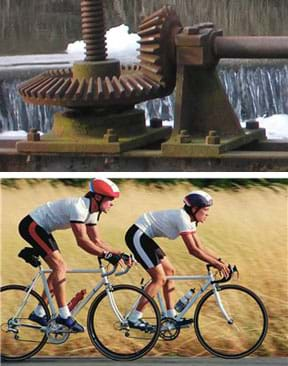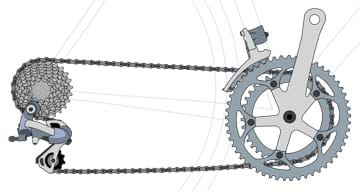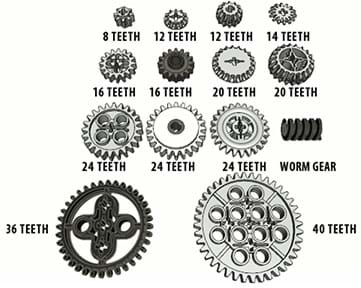Quick Look
Grade Level: 5 (5-7)
Time Required: 45 minutes
Lesson Dependency: None
Subject Areas: Physics, Science and Technology

Summary
Students are introduced to an important engineering element—the gear. Different types of gears are used in many engineering devices, including wind-up toys, bicycles, cars and non-digital clocks. Students learn about various types of gears and how they work in machines. They handle and combine LEGO spur gears as an exercise in gear ratios. They see how gears and different gear train arrangements are used to change the speed, torque and direction of a power source. This prepares them to apply this knowledge in four associated activities in order to create successful solutions to design challenges that use LEGO® MINDSTORMS® EV3 robots. A PowerPoint® presentation, pre/post quizzes and a worksheet are provided.Engineering Connection
Gears represent an important component of many mechanical devices and are usually identified with mechanical engineers (who are sometimes called "gear heads"). Gears are simple machines made up of a wheel and axle. Although it may not be obvious to students before this lesson, gears are pervasive in our world. They are found in the mechanisms of cars, trucks, bikes, pumps, analog watches, wind turbines, bull dozers and most engineering machines.
Learning Objectives
After this lesson, students should be able to:
- Explain the role of gears in mechanical devices.
Educational Standards
Each TeachEngineering lesson or activity is correlated to one or more K-12 science,
technology, engineering or math (STEM) educational standards.
All 100,000+ K-12 STEM standards covered in TeachEngineering are collected, maintained and packaged by the Achievement Standards Network (ASN),
a project of D2L (www.achievementstandards.org).
In the ASN, standards are hierarchically structured: first by source; e.g., by state; within source by type; e.g., science or mathematics;
within type by subtype, then by grade, etc.
Each TeachEngineering lesson or activity is correlated to one or more K-12 science, technology, engineering or math (STEM) educational standards.
All 100,000+ K-12 STEM standards covered in TeachEngineering are collected, maintained and packaged by the Achievement Standards Network (ASN), a project of D2L (www.achievementstandards.org).
In the ASN, standards are hierarchically structured: first by source; e.g., by state; within source by type; e.g., science or mathematics; within type by subtype, then by grade, etc.
NGSS: Next Generation Science Standards - Science
-
Laws are regularities or mathematical descriptions of natural phenomena.
(Grades 6 - 8)
More Details
Do you agree with this alignment?
-
Science knowledge is based upon logical and conceptual connections between evidence and explanations.
(Grades 6 - 8)
More Details
Do you agree with this alignment?
Common Core State Standards - Math
-
Understand the concept of a ratio and use ratio language to describe a ratio relationship between two quantities.
(Grade
6)
More Details
Do you agree with this alignment?
-
Understand the concept of a unit rate a/b associated with a ratio a:b with b ≠ 0, and use rate language in the context of a ratio relationship.
(Grade
6)
More Details
Do you agree with this alignment?
-
Fluently divide multi-digit numbers using the standard algorithm.
(Grade
6)
More Details
Do you agree with this alignment?
International Technology and Engineering Educators Association - Technology
-
Students will develop an understanding of the characteristics and scope of technology.
(Grades
K -
12)
More Details
Do you agree with this alignment?
-
Students will develop an understanding of the relationships among technologies and the connections between technology and other fields of study.
(Grades
K -
12)
More Details
Do you agree with this alignment?
-
Students will develop an understanding of the attributes of design.
(Grades
K -
12)
More Details
Do you agree with this alignment?
State Standards
Missouri - Math
-
Understand the concept of a ratio and use ratio language to describe a ratio relationship between two quantities.
(Grade
6)
More Details
Do you agree with this alignment?
-
Understand the concept of a unit rate a/b associated with a ratio a:b with b ≠ 0, and use rate language in the context of a ratio relationship.
(Grade
6)
More Details
Do you agree with this alignment?
-
Fluently divide multi-digit numbers using the standard algorithm.
(Grade
6)
More Details
Do you agree with this alignment?
Missouri - Science
-
Designed objects are used to do things better or more easily and to do some things that could not otherwise be done at all
(Grades
K -
5)
More Details
Do you agree with this alignment?
Worksheets and Attachments
Visit [www.teachengineering.org/lessons/view/umo_challenges_lesson02] to print or download.Pre-Req Knowledge
Prior to this lesson, it is recommended that students complete the previous unit in the series, How Do Sensors Work?
Introduction/Motivation

How many of you have bicycles? When you ride a bike, how is the energy that your legs generate used to push the bike forward? Any ideas? (Listen to student ideas.) The pedals on the bike turn a gear (looks like a disk with teeth on it), which turns another gear (actually, a pulley), via the chain. Taken together, we generally refer to these parts as "bike gears." How does this arrangement work?
In today's lesson, we will look at different arrangement of gears, called "gear trains," and learn how geared devices can change the speed, torque and direction of a power source. These concepts are important for you to understand so you are ready to tackle the upcoming engineering challenges in this unit! Following the lesson, students can apply their new knowledge of gears and incorporate it into designing a LEGO sumobot with the associated activity design challenge Sumobot Challenge. Then for an added challenge, students can conduct the associated activities Line-Follower Challenge where they are challenged to program LEGO robots with color sensors to follow a black line, and Robot Soccer Challenge where they learn how two LEGO EV3 bricks can be programmed to send and receive messages from each other and respond accordingly.
(Continue by showing the presentation and delivering the content in the Lesson Background section.)
Lesson Background and Concepts for Teachers
This second lesson in the unit introduces students to the concept of gears, which prepares them for the unit's subsequent design challenges that use LEGO MINDSTORMS EV3 taskbots. Have students work individually or in small groups, depending upon the availability of LEGO robot supplies.
Be ready to show students the 17-slide What Are Gears? What Do They Do? Presentation, a Microsoft® PowerPoint® file, to teach the lesson. Have ready a computer/projector with Internet access to also show two online videos and an animation at a website. In advance, make copies of the Gears Pre-Quiz and Gears Post-Quiz (one each per student), provided as both as attachments and slides, and the Get in Gear Worksheet (one per student).
During the lesson, each group needs the following materials:
- one 1/16 beam
- two #6 axles with a bushing on the back side
- 8-tooth gear
- 40-tooth gear
- one additional gear of any size
- LEGO MINDSTORMS EV3 robot, such as EV3 Core Set (5003400) at https://education.lego.com/en-us/products/lego-mindstorms-education-ev3-core-set/5003400#lego-mindstorms-education-ev3. Note: This activity can also be conducted with the older LEGO MINDSTORMS NXT set. You’ll need a computer loaded with the NXT 2.1 software.
- LEGO MINDSTORMS Education EV3 Software 1.2.1, free online, you have to register a LEGO account first; at https://www.lego.com/en-us/mindstorms/downloads/download-software

What Are Gears? What Do They Do? Presentation Outline (slides 1-17)
- Administer the pre-quiz by handing out paper copies; the quiz is also on slide 2. The answers are provided for the teacher on slide 3 for discussion after students have completed the quiz.
- (slide 4) Introduce the lesson objective: What are gears and what do they do? Motivate students to pay attention by pointing out that the concepts in today's presentation are important to learn and understand in order do well in the design challenges that they will participate in during the next class.
- Describe what a gear is using slide 5 and an excellent 11-minute "Gear Basics" video (link on slide 6 and in the Additional Multimedia Support section). Gears come in various sizes and types; they are used to change the speed, torque and direction of a power source. Topics covered in the video: gear types, gear rotation, gear ratio, rates of rotation, mechanical advantage and examples of use (river locks and bicycles).
- (slide 7) Provide an overview of the various types of gears, including spur gears, worm gears, bevel gears and pulleys, as shown in the pictures.
- Either individually or in small groups (depending on the number of supplies available), have students participate in the following simple hands-on exercise to reinforce the concept of gears. Give each group a 1/16 beam, two #6 axles with a bushing on the back side, one 8-tooth gear, one 40-tooth gear and one additional gear of any size (such as a 24-tooth gear).
- Direct students to assemble two gears of different sizes using a simple beam, as shown on slide 8, and then explain gear ratios. A gear ratio tells us how many turns of one gear cause how many turns of the other gear. So with the given gears, the gear ratio is 8:40 or 1:5, meaning that 5 turns of the small gear cause 1 turn of the large gear. (Refer to the associated activity Hare and Snail Challenges for more hands-on exploration to understand the concept of gear-ratios)
- Then make a minor modification, as shown on slide 9, to introduce the concept of idler gears. To do this, students add between the first two gears a third gear of any number of teeth (a 24-tooth gear is shown on slide 9).
- After this exercise, hand out the worksheets and ask students to write answers to its two questions (also on slide 10). Review their answers to check their understanding of gear ratios. As a class, volunteers share their responses and then discuss the answers (provided on slide 11).
- Once students understand the concept of gear ratios, introduce the concept of torque (slide 12). The key point is that at a particular power setting on the LEGO (or any machine), power = torque x speed. If power is constant, explain that torque and speed are inversely related. This means that increasing torque decreases speed, and vice versa.
- Complete the discussion on gear types with the concept of worm gears (slide 13) and belts/pulleys (slide 14). This includes showing students an online worm gear description, animation and 1:43-minute video (links on slide 14 and in the Additional Multimedia Support section).
- Administer the post-quiz by handing out paper copies; the quiz is also on slide 15. The answers are provided on slide 16. Vocabulary terms and definitions are provided on slide 17. Next, conduct the associated activities.
Associated Activities
- Hare and Snail Challenges - Student groups design, construct and test gear ratios and LEGO robot weights in order to make the taskbots go either faster or slower. After the challenges, they explain how different gear ratios affected the robots' speed and torque.
- Sumobot Challenge - Students apply their knowledge of constructing and programming LEGO robots to create sumobots—strong robots capable of pushing other robots out of a ring. While following the steps of the engineering design process, groups consider robot structure, weight and gear ratios in their designs, with the winner decided in a class competition.
- Line-Follower Challenge - Student groups are challenged to program LEGO robots with color sensors to follow a black line. The color sensor acts as the robot "eye" and informs the EV3 computer when the sensor is on the tape and when it's not. The brick is programmed such that it can "decide" how to move the motors so that the color sensor detects the tape, thus ensuring that the robot follows the line. Teams test their ideas for approaches to solve the problem and ultimately learn a (provided) working programming solution.
- Robot Soccer Challenge - In the concluding activity of the unit, students learn how two LEGO EV3 bricks can be programmed to send and receive messages from each other and respond accordingly. Using the (provided) programs, they see how the controller (an EV3 brick acting as the remote control device) sends different Bluetooth messages when its buttons are pressed and how the receiver (a LEGO brick/taskbot) moves when it receives Bluetooth messages. Students examine how the programs work in tandem as they play "robot soccer."
Vocabulary/Definitions
design: Loosely defined, the art of creating something that does not exist.
gear: A rotating machine part with cut teeth that mesh with another toothed part in order to transmit torque; in most cases, the teeth on both gears are identical in shape.
pulley: A wheel on an axle that is designed to support movement and change in direction via a cable/belt/chain along its circumference.
torque: The tendency of a force to rotate an object about its axis or pivot.
Assessment
Pre-Lesson Assessment
Pre-Quiz: Before starting the lesson, administer the two-question Gears Pre-Quiz by handing out paper copies (also on slide 2). The pre-quiz assesses students' prior knowledge about gears and machines with gears. The answers are provided on the Gears Pre-Quiz Answer Key (and slide 3).
Post-Introduction Assessment
Understanding Check: Have students respond to the two-questions provided on the Get in Gear Worksheet (also on slide 10) to check for their comprehension on gear train arrangements and the corresponding effect on the speed of the output gear. Refer to the answers on the Get in Gear Worksheet Answer Key (and slide 11).
Lesson Summary Assessment
Post-Quiz: At lesson end, administer the two-question Gears Post-Quiz by handing out paper copies (also on slide 15). Review students' answers to measure how their knowledge of gears changed during the lesson and assess whether they understand how to apply their knowledge. The answers are provided on the Gears Post-Quiz Answer Key (and slide 16).
Additional Multimedia Support
During the lesson presentation, show students the excellent 11-minute "Gear Basics" video to provide an introduction to gears, suitable for grades 4 to 9. Topics covered: gear types, gear rotation, gear ratio, rates of rotation, mechanical advantage and examples of use (river locks and bicycles). https://www.youtube.com/watch?v=odpsm3ybPsA
During the lesson presentation, show students a worm gear description and animation at https://en.wikipedia.org/wiki/Worm_drive, and its application in a 1:43-minute video, Worm Gear Speed Reducer, at https://www.youtube.com/watch?v=S3XAeMCeZr0.
Subscribe
Get the inside scoop on all things TeachEngineering such as new site features, curriculum updates, video releases, and more by signing up for our newsletter!More Curriculum Like This

Students are introduced to gear transmissions and gear ratios using LEGO® MINDSTORMS® EV3 robots, gears and software. They learn how to build the transmission part of a vehicle by designing gear trains with different gear ratios. Once students learn the principles behind gear ratios, they are put to...

Students learn about electric motors and rotational sensors. They learn that motors convert electrical energy to mechanical energy and typically include rotational sensors to enable distance measuring. Students create a basic program using the LEGO® MINDSTORMS® interface to control a motor to move a...
References
"Gear." Last updated December 2013. Wikipedia, The Free Encyclopedia. Accessed December 2013. http://en.wikipedia.org/wiki/Gear
"Torque." Last updated December 2013. Wikipedia, The Free Encyclopedia. Accessed December 2013. http://en.wikipedia.org/wiki/Torque
Copyright
© 2014 by Regents of the University of Colorado; original © 2013 Curators of the University of MissouriContributors
Sachin Nair, Pranit Samarth, Satish S. NairSupporting Program
GK-12 Program, Computational Neurobiology Center, College of Engineering, University of MissouriAcknowledgements
This curriculum was developed under National Science Foundation GK-12 grant no. DGE 0440524. However, these contents do not necessarily represent the policies of the National Science Foundation, and you should not assume endorsement by the federal government.
Last modified: October 16, 2020







User Comments & Tips